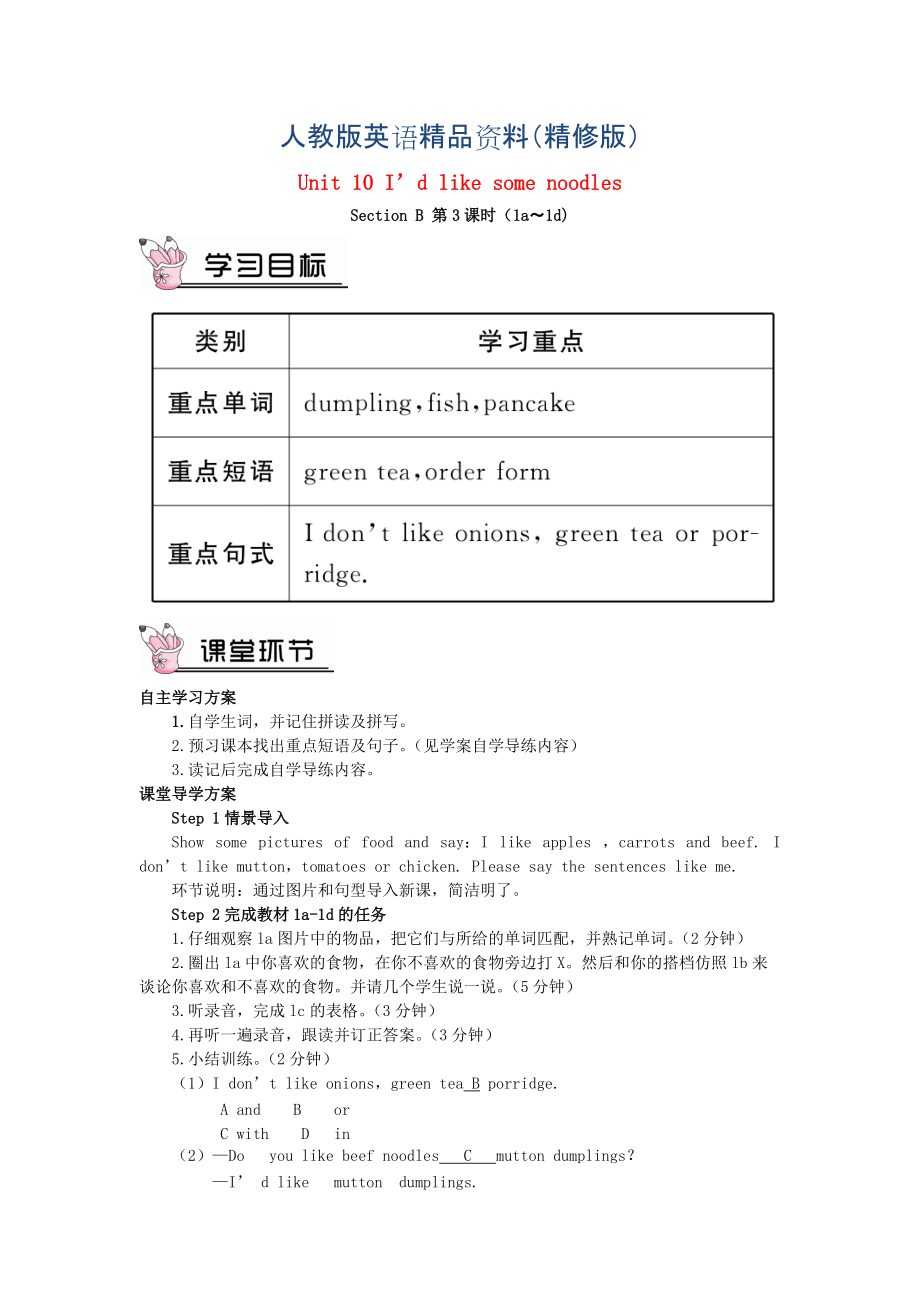《七年級(jí)英語(yǔ)下冊(cè) Unit 10 I’d like some noodles Section B第3課時(shí)導(dǎo)學(xué)案 人教新目標(biāo)版精修版》由會(huì)員分享����,可在線閱讀����,更多相關(guān)《七年級(jí)英語(yǔ)下冊(cè) Unit 10 I’d like some noodles Section B第3課時(shí)導(dǎo)學(xué)案 人教新目標(biāo)版精修版(2頁(yè)珍藏版)》請(qǐng)?jiān)谘b配圖網(wǎng)上搜索����。
1、人教版英語(yǔ)精品資料(精修版)
Unit 10 I’d like some noodles
Section B 第3課時(shí)(1a?1d)
自主學(xué)習(xí)方案
1.自學(xué)生詞����,并記住拼讀及拼寫。
2.預(yù)習(xí)課本找出重點(diǎn)短語(yǔ)及句子����。(見學(xué)案自學(xué)導(dǎo)練內(nèi)容)
3.讀記后完成自學(xué)導(dǎo)練內(nèi)容。
課堂導(dǎo)學(xué)方案
Step 1情景導(dǎo)入
Show some pictures of food and say:I like apples ����,carrots and beef. I don’t like mutton,tomatoes or chicken. Please say the senten
2����、ces like me.
環(huán)節(jié)說明:通過圖片和句型導(dǎo)入新課,簡(jiǎn)潔明了����。
Step 2完成教材1a-1d的任務(wù)
1.仔細(xì)觀察la圖片中的物品����,把它們與所給的單詞匹配����,并熟記單詞。(2分鐘)
2.圈出la中你喜歡的食物����,在你不喜歡的食物旁邊打X����。然后和你的搭檔仿照l(shuí)b來談?wù)撃阆矚g和不喜歡的食物。并請(qǐng)幾個(gè)學(xué)生說一說����。(5分鐘)
3.聽錄音,完成lc的表格����。(3分鐘)
4.再聽一遍錄音,跟讀并訂正答案����。(3分鐘)
5.小結(jié)訓(xùn)練����。(2分鐘)
(1)I don’t like onions����,green tea B porridge.
A and B or
C with D in
3、(2)—Do you like beef noodles C mutton dumplings����?
—I’ d like mutton dumplings.
A.and;some B.and;any
C. or;some D. or;any
(3)— Would you like to go out to play football with me?
— D ����, but I should finish (完成)my homework first.
A. Yes,I do B . I like
C. Of course not D. I’d love t
4����、o
環(huán)節(jié)說明:通過本環(huán)節(jié)的練習(xí)學(xué)生掌握了對(duì)喜惡表達(dá)的綜合運(yùn)用,有效地鞏固了前幾個(gè)課時(shí)所學(xué)的知識(shí)點(diǎn)����。
Step3 問題探究
and和or的用法:
當(dāng)句中有兩個(gè)并列成分時(shí),and/or放在這兩個(gè)成分中間����;當(dāng)句中有三個(gè)或三個(gè)以上并列成分時(shí)����,and/ or只用在最后兩個(gè)成分之間����,前面的用逗號(hào)隔開。and常用于肯定句中����,而or常用于否定句中。例如:
I don’t like chicken or beef.我不喜歡雞肉和牛肉����。
I like onions����,green tea and porridge.我喜歡洋蔥、綠茶和粥����。
練習(xí):
(1)Come on, C you will be
5����、late for school.
A and B but
C or D so
(2)He doesn’t kwon you B me
A and B or
C but D /
(3)I’d like one bowl of noodles A one pancake.
A and B or
C but D so
(4)There is not water A not air there.
A and B or
C but D /
Step 4 家庭作業(yè)
完成課后提升作業(yè)(學(xué)案p. 66)����。
教學(xué)反思
本課時(shí)以圖片和常用句型導(dǎo)入新課����,同時(shí)通過聽、讀訓(xùn)練����,培養(yǎng)學(xué)生學(xué)習(xí)興趣,鞏固所學(xué)知識(shí)����。
 七年級(jí)英語(yǔ)下冊(cè) Unit 10 I’d like some noodles Section B第3課時(shí)導(dǎo)學(xué)案 人教新目標(biāo)版精修版
七年級(jí)英語(yǔ)下冊(cè) Unit 10 I’d like some noodles Section B第3課時(shí)導(dǎo)學(xué)案 人教新目標(biāo)版精修版

